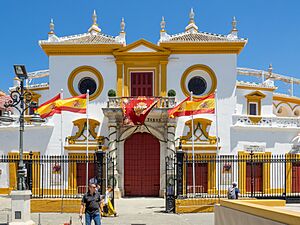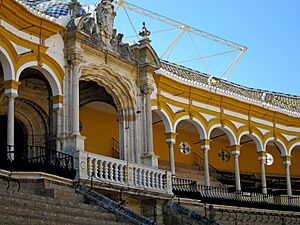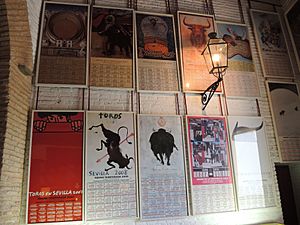Maestranza (Seville) facts for kids
The Plaza de Toros de la Real Maestranza de Caballería de Sevilla is a famous building in Seville, Spain. It is a large arena where traditional events, like bullfights, take place. This arena can hold about 12,000 people.
It is especially well-known for the events held during the annual Seville Fair. The Plaza de Toros is also part of a special group called the Real Maestranza de Caballería de Sevilla. This group was created a long time ago for cavalry training. Many people visit this historic place every year. It is considered one of Seville's most interesting tourist spots.
Contents
Building History of the Bullring
The construction of this circular arena began in 1749. It was built on Baratillo Hill, replacing an older, rectangular arena. In 1761, new sections, called ochavas, were added. Each ochava was made of four arches.
The inner part of the arena, known as the Palco del Príncipe (Prince's Box), was finished in 1765. This special box has two main parts. One is a gate where successful bullfighters would exit. The other is a private viewing area for the Spanish royal family. The top of the box has four arches and a beautiful dome. This dome is covered with white and blue tiles. A Portuguese sculptor named Cayetano de Acosta created the sculptures on the box. It was built for Prince Felipe de Borbón.
Construction Pauses and Resumes
Work on the arena stopped in 1786. This happened because King Carlos III banned bullfighting events. At that time, only one-third of the arena was complete. Another old viewing area, the Palco de la Diputación, also dates from this period. It is located opposite the Prince's Box.
After 34 years, about half of the arena's covered sections were finished. By 1868, the Palco de la Diputación needed repairs. An Italian sculptor, Augusto Franchy, rebuilt it. He added a new area with a marble railing and the crest of the Real Maestranza. Five balconies were also added on each side of this box. The arena's clock is now located there. The entire bullring was finally completed in 1881. Two-thirds of it was made of stone, and the rest was wood.
Modern Updates to the Arena
Between 1914 and 1915, the stone grandstands were rebuilt. This work was done using brick by architect Aníbal González. All the seating rows were made smoother. New shaded seating areas were added, along with rows in the sun. A special row of armchairs was also built in the shaded section.
The Bullfighting Season
The bullfights held in Seville during the Feria de Abril are very important. They are the biggest events in the city's bullfighting calendar. The regular season for these events usually runs from March or April until late September. Each year, the Real Maestranza asks an artist to create a poster. This poster announces the upcoming bullfighting season at the Royal Bullring.
Visiting the Bullring
You can take regular tours of the Bullring and its museum. These tours help visitors learn about the history and culture of this famous Spanish landmark.
See also
 In Spanish: Plaza de toros de Sevilla para niños
In Spanish: Plaza de toros de Sevilla para niños





